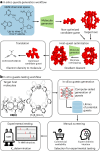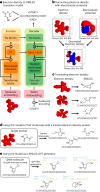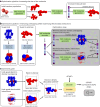Electron density-based GPT for optimization and suggestion of host-guest binders
- PMID: 38459272
- PMCID: PMC10965440
- DOI: 10.1038/s43588-024-00602-x
Electron density-based GPT for optimization and suggestion of host-guest binders
Abstract
Here we present a machine learning model trained on electron density for the production of host-guest binders. These are read out as simplified molecular-input line-entry system (SMILES) format with >98% accuracy, enabling a complete characterization of the molecules in two dimensions. Our model generates three-dimensional representations of the electron density and electrostatic potentials of host-guest systems using a variational autoencoder, and then utilizes these representations to optimize the generation of guests via gradient descent. Finally the guests are converted to SMILES using a transformer. The successful practical application of our model to established molecular host systems, cucurbit[n]uril and metal-organic cages, resulted in the discovery of 9 previously validated guests for CB[6] and 7 unreported guests (with association constant Ka ranging from 13.5 M-1 to 5,470 M-1) and the discovery of 4 unreported guests for [Pd214]4+ (with Ka ranging from 44 M-1 to 529 M-1).
© 2024. The Author(s).
Conflict of interest statement
The authors declare no competing interests.
Figures






References
-
- Atz K, Grisoni F, Schneider G. Geometric deep learning on molecular representations. Nat. Mach. Intell. 2021;3:1023–1032. doi: 10.1038/s42256-021-00418-8. - DOI
Grants and funding
LinkOut - more resources
Full Text Sources

